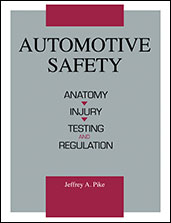Technical Paper
A Crash Simulation of Instrument Panel Knee Bolster Using Hybrid III Dummy Lower Torso
1995-02-01
951067
This paper reports the analytical procedure developed for a simulation of knee impact during a barrier crash using a hybrid III dummy lower torso. A finite element model of the instrument panel was generated. The dummy was seated in mid-seat position and was imparted an initial velocity so that the knee velocity at impact corresponded to the secondary impact velocity during a barrier crash. The procedure provided a reasonably accurate simulation of the dummy kinematics. This simulation can be used for understanding the knee bolster energy management system. The methodology developed has been used to simulate impact on knee for an occupant belted or unbelted in a frontal crash. The influence of the vehicle interior on both the dummy kinematics and the impact locations was incorporated into the model. No assumptions have been made for the knee impact locations, eliminating the need to assume knee velocity vectors.

